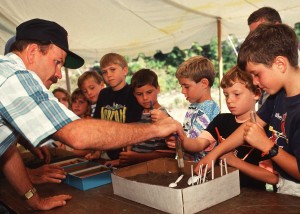Applying the Learning Cycle: Teaching Strategies using Water Examples
PERCEIVING AND PROCESSING INFORMATION: The Learning Cycle
How we process information and experiences (what we do with new information and experiences) varies along a continuum from “reflective observation” to “active experimentation.” We process our experiences by reflecting about them, filtering new learning through our experiences. Then we process new learning by acting on it, by trying things out.
The combination of how you perceive and process information and experiences forms your unique learning style. It is important to remember that these are continua, not either-or choices. McCarthy (2000, 1980) describes the interplay between the two continua by referring to a clock. The learning process flows around the learning cycle just as hands move around a clock. She refers to 12 o’clock as the sensory or “me” place. Learning begins at “me” where we sense our world (direct experience) and moves to 3 o’clock where we reflect about it and assimilate it. This enables us to examine our experience and conceptualize it. The 6 o’clock place is the “it” place, where we name and make generalizations about things—objects, concepts and ideas.
After we experience and conceptualize it, we try it out to see if we can make some personal meaning out of this experience. We move to 9 o’clock where we transform the idea or concept through active experimentation. It is not enough to understand the experience, we want to test it, play with it, and see if it works.
Finally, we return to the “me” place with our new direct experience. We integrate our experience, reflections, conceptualizations and actions together, shaping them into something new. We internalize it and adapt it. We are transformed. We have learned. And it is 11:59! And we are ready to go through the cycle again.
This flow from experience to reflection, conceptualization and experimentation forms a spiraling learning cycle that begins and ends with “me”. The complete cycle is more important than any one part of it. Within the cycle, there is no hierarchy. Each completed cycle leads to more learning and the cycle continues in a spiral mode. We make meaning, form concepts, take actions, and adapt new behaviors. However, we tend to be more comfortable with some parts of the cycle than others. We have preferred learning styles.
Step 1: Connect — establish a relationship between the learners and the content (information and experience), connecting it to their lives.
Step 2: Attend — analyze what just happened by attending to their own experience.
Step 3: Imagine — visualize the concept, as the learners understand it and experienced it.
Step 4: Inform — receive and examine the expert knowledge.
Step 5: Practice — practice the learning as the experts do it.
Step 6: Extend — see how it works for the learner.
Step 7: Refine — evaluate the extension from Step 6.
Step 8: Perform — look for relevance and connections to larger ideas that are immediately useful to the learner.
REFERENCES
McCarthy, B. (2000). About Teaching: 4MAT® in the Classroom. Wauconda, IL: About Learning, Inc.
McCarthy, B. (1980). The 4MAT® System: Teaching to Learning Styles with Right/Left Mode Techniques. Barrington, IL: EXCEL, Inc.
About Learning | Official Site of Bernice McCarthy’s 4MAT System




